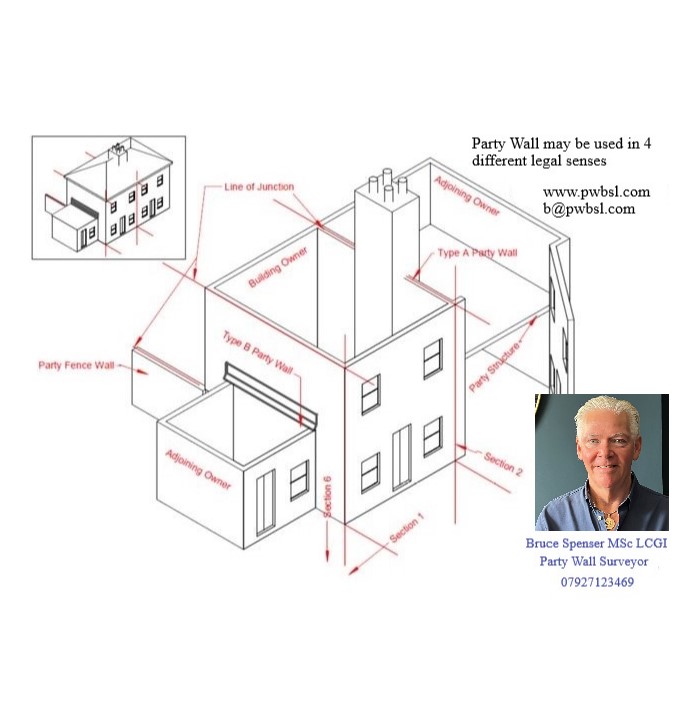The psychology of Party Wall disputes and methods of resolution and the difference between disputes, bullying and harassment
A person who makes the wrong choices is unaware of the conscious choices available to them and are governed by their evolved instinct; “They are” (Rene Descartes) but they are not in control and are unaware of their lack of control. A Party Wall Surveyor needs to understand the psychology of all participants in order to carry out their statutory role
From a psychological standpoint a dispute (a disagreement) must exist in two minds. The greek prefix di means two, twice etc. Spute from the old English to discuss
There must be a commonality between those two minds ie:
· Location
· Property
· Ownership
· Employment or Profession
There must be knowledge of the dispute by both minds. A dispute does not exist if a victim is being bullied or harassed – see below.
Once knowledge exists of the dispute both minds (parties) are empowered. This empowerment can be stressful if it is accompanied by uncertainty. Stress generated can be exacerbated by a parties reaction to stress caused by for example:
· Current emotional condition
· Nurtured emotional condition
· Natural emotional condition
The stress generated can be used by one party to increase their power to the detriment of the other.
The methods available to settle disputes are indicative of societies perception of the hierarchy of disputes ie:
· Statutory
o Arbitrator
o Mediator
o Conciliator
o Early neutral evaluator
· Police
· Council
· Authority
· Willing parties acting reasonably without coercion
Bullying and Harassment
“Bullying
is a compulsive need to displace aggression and is achieved by the expression of inadequacy (social, personal, interpersonal, behavioral, professional) by projection of that inadequacy onto others through control and subjugation(criticism, exclusion, isolation etc). Bullying is sustained by abdication of responsibility (denial, counter-accusation, pretence of victim-hood) and perpetuated by a climate of fear, ignorance, indifference, silence, denial, disbelief, deception, evasion of accountability, tolerance and reward (eg promotion) for the bully.”
Tim Field, 1999
Bullies aim to control, discredit, isolate and eliminate their target, they have no integrity, are vindictive, aggressive, demanding and regularly violate other’s boundaries and rights – their “requests” always have a negative consequence. They intend to cause the victim harm, undermine them, damage them socially, emotionally, psychologically and sometimes physically. This is all the Bully’s choice by the use of unwarranted criticism and threats.
The major triggers for bullying come from the bully’s own sense of inadequacy, they feel envious and threatened by competent, popular people with integrity. The bully will project their own incompetence and inadequacy onto the target by gossip and the gossip mongers will unwittingly or wittingly be the bully’s accomplice if they are vulnerable, gullible or spiteful.
Their victim is singled out because they are superior in every way to the bully: They are:
· Morally Courageous
· Strong
· Highly developed empathy
· Sensitivity for others
· High degree of perceptiveness
· high moral values
· Well-developed integrity
· Strong sense of fair play and reasonableness
· A low propensity to violence
· Reluctance to pursue a grievance, disciplinary or legal action
· A strong forgiving streak
· Mature understanding of the need to resolve conflict with dialogue
· Self-Reliant
· Individualistic
· Non-group member
the bully confuses the attributes as weaknesses not the strengths they are. Bullying is by Scapegoating, projection, vilification, retaliation and grooming bystanders:
Scapegoating is moving blame, responsibility, angry feelings, undealt with pain and accusations from themselves to others.
To distract and divert attention from themselves the bully Projects their own inadequacies, shortcomings, behaviors, anger, spite and self-deception on to the target – the projector does this by blame, criticism and allegation. Their attack on the target actually mirrors who they are and gives an awareness of the bully’s own misdemeanors.
Vilification is the attempt to mask the bullying by the bully accusing the target of being the bully – the aim is to put the target on the defensive (feigning victim-hood).
The bully grooms bystanders (and the target) with lies and misinformation and encourages them to further disseminate by gossip. The most easily groomed by gossip are those who lack critical analytical thinking skills.
A bully will focus and attempt to exercise power over and on an individual. There is no commonality between those minds. The determination of whether or not a person is being bullied or harassed is the victim’s perception of being caused alarm, distress or intimidation. Even if the bully claims they did not mean to alarm, distress or intimidate the Equality Act applies on the way the victim feels.
Bullying is part of group dynamics – a group will demand similar behavior or will ostracise or bully members or those attempting to join, the group members are willing or unwilling collaborators (you become who you associate with/who you work with/who your employer is etc – for example gay people were bullied out of the Army, London Transport etc not so long ago) – conversely a modern team will not act in such a manner (but of course the old teams of the Army, London Transport etc did!) This type of bullying was first studied in the Hawthorne experiments in the early 20th century and it applies equally to public places, clubs, institutions, work, social, family and neighborly situations.
A Building Owner (or their Surveyor) who is being bullied by an Adjoining Owner’s appointed surveyor to the extent that the required award is impossible unless they submit to the unreasonable demands of the bullying surveyor should sideline the surveyor by utilising the act to go to the third surveyor. What they should be aware of is that the bully will attempt to vilify, project etc onto the other surveyor and groom the third surveyor into believing they are the innocent party; this emphasises the importance of Third Surveyor selection; the selected third surveyor must be an experienced master of critical analytical thinking and dispute resolution. A bullying Party Wall Surveyor should immediately be reported to their Institute for disciplinary action.
In work, clubs, institutions etc bullying will fall foul of statutes and could also be criminal and authority figures should immediately be involved.
Neighborly bullying is common in small and remote communities and is generally driven by group dynamics and fueled by the grooming by gossip of those less able to critically analytically think. The bully is driven by loneliness, depression, un-dealt with loss, jealousy, hate, suppressed and un-dealt with anger etc. The bully’s un-dealt with passions will be fixated upon the target which will lead to a form of paranoia and mental disturbance within the bully. The target will become aware of the bully’s obsession with them when the bully acts outwardly by for example invading their space, vengeful, spiteful and other actions against them. The target should avoid a natural temptation to retaliate as this will only empower the bully and alter the dynamics from bully and victim into a dispute – The target should retain the upper ground at all times by being polite and understanding to and of the bully indeed the greatest danger the target faces is to be provoked by the bully because of the withholding of the natural instinct to retaliate. If the bully breaks statute or common law etc it is essential that the police are informed who have the power to treat the matter as a hate crime. They can also take the matter to court.
It must also be recognised that pubs, restaurants and cafes are for locals (outside season) and so if a person is subject to bullying in such public places it may be the best option to just stop going to them.
Arrested Development Bully: Children play, they experiment with structures and boundaries; This can include spiteful, hateful and violent behavior. (In extremis when removed from adult supervision their behavior can become pathological). If a child is subject to bullying from within such a situation (Boarding School, Child retention institutions, inadequate family etc), the child can be so disturbed by the situation that their psychological development becomes partly arrested. The deep seated pain within the child becomes the anger of the adult bully (and in extremes the sociopath and the psychopath; The most devious type of bully; they have lost the ability of empathy and sympathy and care purely for themselves). From the behavior of the adult bully can be extrapolated the age of the child when the disturbance happened and the understanding required is of this child within not the adult.
The Operant Conditioning of the Greedy Party Wall Surveyor:
Party Wall Surveyors are conditioned by the responses they receive from their actions and the environment they are able to create. As a Party Wall Surveyor explores the fees they can charge some discover that creating a bullying environment will increase the work they do (and subsequently the fees they charge) and/or enable them to hold the other surveyor/Building Owner to ransom when negotiating their consequential exorbitant fees. The positive reinforcement of receiving their exorbitant fees will create a spiral of decline in the ethics of the surveyor and an upward spiral to seek even greater fees; a further consequence will be loss of esteem of the profession by the general public who have to pay. That is why it is essential that exorbitant fees and unethical behavior are challenged by the Building owner’s surveyor, if not they are contributing to the bullying surveyor’s positive reinforcement and are as guilty as that surveyor who is exploring the limits of the fees they can get away with. (behaviorism: James, Pavlov, Watson, Kuo, Wolpe, Bandura, Skinner)
nb: Party Wall Surveyors are conditioned by the responses they receive from their actions or environments. Positive or negative reinforcement influence future behavior. If a behavior results in a negative consequence the behavior will decrease and conversely a positive consequence will increase that behavior. The ideal of behaviorism is to eliminate coercion, to apply controls by changing the environment (however stick and carrot and discipline will suffice in the short term if necessary), it therefore follows that the way to control such greedy surveyors is by a Professional Institute for Party Wall Surveyors and the author recommends this is provided by the Institute which is best placed; The Chartered Institute of Building.
BF Skinner altered the preceding thought process of classical conditioning ie Pavlov (a preceding stimulus determined behavior) and showed that operant conditioning follows as a consequence of behavior.
Risk (and Value) in the Party Wall Dispute
Risk is measurable uncertainty; uncertainty is unmeasurable risk. There are known knowns, known unknowns and unknown unknowns which can generally quantified/ risk analysed, subject to, “bounded rationality*”, as follows:
- known knowns = a positive, a surety; for example:
- Previous behavior – in similar circumstances the same decision will be reached (requires previous experience*)
- Act to best advantage – (more likely in a mature, non-programmed person*)
- known unknown = either or which allows for contingency planning
- no previous behavior* allows a choice in experimenting what is acting to the best advantage
- unknown unknowns – anything can happen*
Risk is further explained and what it relates to as follows:
- Risk is measurable uncertainty; uncertainty is unmeasurable risk
- Hazards are pre-existing conditions that have the potential to inflict some negative impact
- Risk is the probability, or likelihood, of a particular event’s occurrence.
- Risk is also the impact an uncertain event could have
Risk is therefore a combination of the probability, or frequency, of the occurrence of a defined hazard and the magnitude of the consequences of the occurrence.
Problems of uncertainty can be dealt with by using probabilities derived from observation and past experience (Mathematical tools ie game theory, reasoned intellect: the prisoner’s dilemma). At the most basic level a risk analysis is performed of probability v impact which can be taken a step further mathematically by utilising the gain or loss * the probablility which gives a net probable benefit.
It is essential that the Party Wall Surveyor utilise concepts in order to better understand themselves and their relationship with others; this will primarily assist them in ensuring their actions are ethical and professional (posts and blogs) and secondly enable them to analyse and then determine and quantify the probabilities of the actions of others.
Risk (and value) become problematic in a party wall dispute when:
- The purpose and objective of the Party Wall Act are not understood or not followed
- The value* lies in allowing the Building Owner to expeditiously proceed with their lawful works, ensuring the principal factors of the project; Time, cost, safety and quality whilst recognising and protecting the interests of the adjoining owner.
- *Value = desirability = exchange in an open market dependent upon marginal utility, added value, value for money, best value and personal value
- The value* lies in allowing the Building Owner to expeditiously proceed with their lawful works, ensuring the principal factors of the project; Time, cost, safety and quality whilst recognising and protecting the interests of the adjoining owner.
- The risks are not considered before proceeding to settle the dispute
- The financial risk to the Building Owner by delay, security, damages
- The risk to the adjoining owner (the external environment of the project; the interface of the what can become two competing systems)
- if the purpose and objective are not understood the risks can not be considered
Risk Value = Probability of Event x Cost of Event is determined intellectually as follows:
- identify
- analyse
- epistemic
- stochastic
- aleatoric
- evaluate
- epistemic
- stochastic
- aleatoric
- allocate
- manage.
and mitigated as follows:
- avoid
- share
- accept
- control
The act allows that the risk be allocated to the party who is most suited to manage them; Building Owner, who shall bear the price.
Therefore the raison d’etre of the Party Wall Act is the mitigation of risk for both owners as swiftly as possible by an award and in order so to do the Building Owner must provide all necessary information. Therefore if the Building Owner provides all necessary information where do the risks come from?
How does an owner etc spot Inadequate Party Wall Surveyors
The answer is remarkably simple;
it is when one or more of the surveyor acts (or omits to act) to a standard which falls short of that expected of the reasonable man on the Clapham Omnibus, they are negligent, and this can be recognised by certain behaviors:
- Racking up unnecessary fees
- Excessive and unnecessary actions
- Utilising checking engineers
- Not utilising modern methods of communication and indeed insisting on outmoded methods
- Inability to understand structural drawings, plans etc
- Inconsistency in their communications
- Employing inadequately qualified people to carry out schedule of conditions
- Advising and indeed seeking excessive security for expenses
- Utilising non privy council suffixes without advising all parties involved that they do not denote a degree, Chartered Status etc
- Utilising unnecessary suffixes
- Inadequate notices
- A lack of understanding of Construction
- A lack of understanding of the act
- A lack of understanding of the law and case law
- Slyly hiding their true motives
- Vilification – attempting to surreptitiously transfer the blame onto others by creating false narratives or distorting facts and the truth
- Working against the spirit of the act ie working to frustrate the Building Owner’s project to the benefit of an aggrieved adjoining owner. They are then in Conflict: They have a contract to frustrate the Building Owner but also take on the statutory, quasi-judicial role of the party wall surveyor – in effect they have become a party to the matter in contradiction with Section 20; “surveyor” means any person not being a party to the matter appointed or selected under section 10 to determine disputes in accordance with the procedures set out in this Act.
As the above behaviors gradually become apparent the more probable others of the above will so do because of positive operant conditioning.
When such a pattern of behavior is established ideally a plan should be formulated to corall the culprit as follows:
- Careful critical analysis and scrutiny of all actions and communications within a time based record containing data only and no opinions.
- Changing the environment by the involvement of the Third Surveyor.
- If the Third Surveyor is not competent so to do an award must be agreed without the fees of the culprit included and then the matter must be passed elsewhere.
- Utilise Section 10 (6) or 10 (7) of the act
However the work involved to act in an ideal manner will far outweigh the excessive fees sought by the culprit which is the reason they generally get away with it. However where the opportunity arises to curtail the behaviour of such miscreants it should not be passed up because the negative operant conditioning will assist in reducing such behaviour.HoII
Party Wall Surveyor serving Thanet and London
Third Surveyor serving England and Wales


